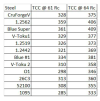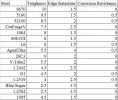-
The BladeForums.com 2024 Traditional Knife is ready to order! See this thread for details: https://www.bladeforums.com/threads/bladeforums-2024-traditional-knife.2003187/
Price is$300$250 ea (shipped within CONUS). If you live outside the US, I will contact you after your order for extra shipping charges.
Order here: https://www.bladeforums.com/help/2024-traditional/ - Order as many as you like, we have plenty.
You are using an out of date browser. It may not display this or other websites correctly.
You should upgrade or use an alternative browser.
You should upgrade or use an alternative browser.
True or False?
- Thread starter Ironic
- Start date
Jack of All Blades
Platinum Member
- Joined
- Nov 12, 2017
- Messages
- 1,751
True and false. Depends how you cook it.
420HC is pretty darn tough, but it has poor edge wear. However, the other steels mentioned also have poor edge retention. Depending on heat treat, it could be true or false.
On Larrin's site, he rates these steel in general terms:
420HC as 9 for toughness and 2.5 for edge holding.
CruForgeV is 8 and 2.5, respectively.
1084 is 8 and 1.5
A2 is 6.5 and 2.5
52100 is 8.5 and 2
1095 is 4.5 and 1.5
On Larrin's site, he rates these steel in general terms:
420HC as 9 for toughness and 2.5 for edge holding.
CruForgeV is 8 and 2.5, respectively.
1084 is 8 and 1.5
A2 is 6.5 and 2.5
52100 is 8.5 and 2
1095 is 4.5 and 1.5
Ironic
Platinum Member
- Joined
- Jan 1, 2011
- Messages
- 721
420HC is pretty darn tough, but it has poor edge wear. However, the other steels mentioned also have poor edge retention. Depending on heat treat, it could be true or false.
On Larrin's site, he rates these steel in general terms:
420HC as 9 for toughness and 2.5 for edge holding.
CruForgeV is 8 and 2.5, respectively.
1084 is 8 and 1.5
A2 is 6.5 and 2.5
52100 is 8.5 and 2
1095 is 4.5 and 1.5
Reading through Larrin’s charts on a laid-back Sunday morning was what prompted my original post. I had noticed how high his toughness rating was for 420HC a couple of times before, but today I was looking more closely at some of the well-known carbon steels and was struck by how low they were ranked in edge holding on his charts. As I went down the list today making comparisons with 420HC, I started wondering how many others here might be shaking their heads as much as I was. I’m well past the age people ask for credentials before granting me a senior discount, and I can remember when many of these carbon steels had legendary reputations for both toughness and edge holding. Ed Fowler’s 52100. Phill Hartsfield’s A2. Don Fogg’s 1095. Even the admonitions of Julia Child, who swore by the properties of carbon steels over stainless in the kitchen. Was my imagination that completely captured by bald-faced marketing and anecdotal evidence over the years? Of course, my first thoughts ran to heat treat differences, but that’s pretty obvious. Larrin’s rankings are general in nature and would require some calibration, obviously, for individual cases. But just as obviously, his rankings don’t indicate any general caveats based on heat treatment.
Maybe he’ll comment here. Would love to see whatever he might have to add.
Last edited:
Larrin
Gold Member
- Joined
- Jan 17, 2004
- Messages
- 5,032
Simple carbon steels have soft iron carbides and thus have quite low wear resistance. A2 is a high alloy tool steel so it is in a different category, it has chromium carbides and thus its wear resistance is more in line with a stainless steel like AEB-L. 52100, 1095, and A2 all have relatively little carbide as well. Now it is importantly to remember that steel is only one part of edge retention, and the wear resistance of steel sometimes won’t matter as much for edge retention if the edges are chipping or rolling.
Ironic
Platinum Member
- Joined
- Jan 1, 2011
- Messages
- 721
Thanks for taking time to respond—much appreciated.
But my understanding from your response overall is that you have no other exceptions to share that might result in any of these carbon steels excelling beyond what would be expected from your rankings?
Thanks again.
I’m assuming that edge retention is typically reduced even further in cases of chipping or rolling, unless a temporary “micro-serration” effect might result serendipitously from chipping that leaves a “saw-tooth” edge?…steel is only one part of edge retention, and the wear resistance of steel sometimes won’t matter as much for edge retention if the edges are chipping or rolling.
But my understanding from your response overall is that you have no other exceptions to share that might result in any of these carbon steels excelling beyond what would be expected from your rankings?
Thanks again.
- Joined
- Jul 30, 2006
- Messages
- 43,835
I remember many reviewers who were disappointed that Gerber used 420HC for the Strongarm. But it passed all their heavy-duty field usage tests and they kept saying what a great knife it is. I also remember Andrew Demko praising the properties of 4116, which is fairly close to the composition of most 420HC steel compositions (420HC is not an official designation, so the composition varies a bit among the various producers). So this is not altogether shocking to me.
Larrin
Gold Member
- Joined
- Jan 17, 2004
- Messages
- 5,032
If you mean exceptions in terms of the properties of the steels, no.Thanks for taking time to respond—much appreciated.
I’m assuming that edge retention is typically reduced even further in cases of chipping or rolling, unless a temporary “micro-serration” effect might result serendipitously from chipping that leaves a “saw-tooth” edge?
But my understanding from your response overall is that you have no other exceptions to share that might result in any of these carbon steels excelling beyond what would be expected from your rankings?
Thanks again.
If you look in Ankerson's test results for edge wear in the Knife Reviews and Testing subform, you'll see that CruForgeV with a custom heat treat by Luong at 62 Rc can have the edge wear ability of Spyderco S30V at 60 Rc -- each with 300 cuts of rope to a specific point of dullness.Thanks for taking time to respond—much appreciated.
I’m assuming that edge retention is typically reduced even further in cases of chipping or rolling, unless a temporary “micro-serration” effect might result serendipitously from chipping that leaves a “saw-tooth” edge?
But my understanding from your response overall is that you have no other exceptions to share that might result in any of these carbon steels excelling beyond what would be expected from your rankings?
Thanks again.
S30V would be much better than 420HC in most circumstances. Larrin gives S30V a 6 on edge wear as a general guide, well above 420HC's 2.5. Heat treat is important.
From Ankerson's post:
CruForgeV - 300 - Bluntcut Custom - 62 HRC - .012" behind the edge
S30V - 300 - Military - 60 RC
- Joined
- Jun 5, 2012
- Messages
- 29,189
I think it's often a surprise to people when their favorite steels turn out to be less tough than they thought. But does it matter if the knife is never pushed to the point of failure? Not really. "Tough enough" works for most people.
I do like the details of steel attributes though and find it interesting as a knife nut.
I do like the details of steel attributes though and find it interesting as a knife nut.
ferider
Platinum Member
- Joined
- Jun 20, 2018
- Messages
- 15,089
Thanks for taking time to respond—much appreciated.
I’m assuming that edge retention is typically reduced even further in cases of chipping or rolling, unless a temporary “micro-serration” effect might result serendipitously from chipping that leaves a “saw-tooth” edge?
But my understanding from your response overall is that you have no other exceptions to share that might result in any of these carbon steels excelling beyond what would be expected from your rankings?
Thanks again.
Have a look at the still reasonable toughness of CruForgeV, 52100 and 1095 @64 RC:

(https://knifesteelnerds.com/2021/02...ate-events-that-killed-a-forging-knife-steel/)
Now try to find a 64 RC number for 420HC.
Ironic
Platinum Member
- Joined
- Jan 1, 2011
- Messages
- 721
This brings up an interesting (to me) point. Obviously the performance of a steel in terms of toughness and edge holding changes with the heat treat. So how do you arrive at your steel performance rankings without referencing how a specific heat treat protocol was chosen and how the rankings might change given different heat treat protocols?If you mean exceptions in terms of the properties of the steels, no.
Thanks again
- Joined
- Jul 30, 2006
- Messages
- 43,835
Have you looked at his charts? They plot properties against hardnessesThis brings up an interesting (to me) point. Obviously the performance of a steel in terms of toughness and edge holding changes with the heat treat. So how do you arrive at your steel performance rankings without referencing how a specific heat treat protocol was chosen and how the rankings might change given different heat treat protocols?
Thanks again
Larrin
Gold Member
- Joined
- Jan 17, 2004
- Messages
- 5,032
They are normalized to the same hardness apart from a few steels that are exclusively at lower or higher hardness. Many steels have been tested at a range of hardness with different heat treatments of course. Ratings are a simplification for comparison.This brings up an interesting (to me) point. Obviously the performance of a steel in terms of toughness and edge holding changes with the heat treat. So how do you arrive at your steel performance rankings without referencing how a specific heat treat protocol was chosen and how the rankings might change given different heat treat protocols?
Thanks again


